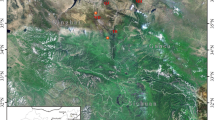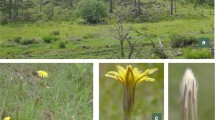Abstract
Medicago archiducis-nicolai Sirjaev and M. ruthenica (L.) Ledebour are two phylogenetically closely related species in the section Platycarpae within Medicago. M. archiducis-nicolai is endemic to the Qinghai–Tibetan Plateau (QTP), shows more tolerance to abiotic stress than M. ruthenica, which inhabits relatively temperate areas, and has the potential to be domesticated and used as a legume forage germplasm in alpine meadows. Here, we analyzed the population genetic structure and genetic diversity of these species using 20 putatively neutral EST-SSR markers. Twenty-four wild populations, including 21 M. archiducis-nicolai and 3 M. ruthenica, were divided into two clusters that were consistent with current taxonomy. The 21 M. archiducis-nicolai populations were clustered into two geographically related groups. Positive relationships between population genetic distance and geographical factors, including geographical distance and altitudinal difference, revealed that the genetic differentiation of M. archiducis-nicolai populations was driven by both geographical distance and the complex topography of the QTP. Medicago archiducis-nocilai, a narrow-range endemic on the QTP, had lower genetic diversity than the more widespread M. ruthenica. Medicago archiducis-nicolai populations from the central platform of the QTP had relatively high genetic diversity, whereas those occupying the east platform and edge of the QTP showed variable levels of genetic diversity, implying the presence of refugia on the central platform. These results have implications for the genetic resource management and exploitation of M. archiducis-nicolai and provide novel insights into the mechanisms underlying the adaptation of this species to the harsh environment of the QTP.




Similar content being viewed by others
References
Antao T, Lopes A, Lopes RJ, Beja-Pereira A, Luikart G (2008) LOSITAN: A workbench to detect molecular adaptation based on a Fst-outlier method. BMC Bioinformatics 9:323. https://doi.org/10.1186/1471-2105-9-323
Balabaev GA (1934) Yellow lucernes of Siberia, Medicago ruthenica (L.) Lebd. and M. platycarpos (L.) Lebd. Bull App Bot Genet Plant Breed Serv 7:113–123
Campbell TA, Bao G, Xia ZL (1997) Agronomic evaluation of Medicago ruthenica collected in Inner Mongolia. Crop Sci 37:599–604
Campbell TA, Bao G, Xia ZL (1999) Completion of the agronomic evaluations of Medicago ruthenica ((L.) Ledebour) germplasm collected in Inner Mongolia. Genet Resour Crop Evol 46:477–484
Chen SY, Wu GL, Zhang DJ, Gao QB, Duan YW, Zhang FQ, Chen SL (2008) Potential refugium on the Qinghai-Tibet Plateau revealed by the chloroplast DNA phylogeography of the alpine species Metagentiana striata (Gentianaceae). Bot J Linnean Soc 157:125–140. https://doi.org/10.1111/j.1095-8339.2008.00785.x
Clauss MJ, Cobban H, Mitchell-Olds T (2002) Cross-species microsatellite markers for elucidating population genetic structure in Arabidopsis and Arabis (Brassicaeae). Mol Ecol 11:591–601
Doyle JJ (1987) A rapid DNA isolation procedure for small quantities of fresh leaf tissue. Phytochem Bull 19:11–15
Earl DA, Vonholdt BM (2012) STRUCTURE HARVESTER: a website and program for visualizing STRUCTURE output and implementing the Evanno method. Conserv Genet Resour 4:359–361
Ellwood SR, D’Souza NK, Kamphuis LG, Burgess TI, Nair RM, Oliver RP (2006) SSR analysis of the Medicago truncatula SARDI core collection reveals substantial diversity and unusual genotype dispersal throughout the Mediterranean basin. Theoret Appl Genet 112:977–983
Evanno G, Regnaut S, Goudet J (2005) Detecting the number of clusters of individuals using the software STRUCTURE: a simulation study. Mol Ecol 14:2611–2620. https://doi.org/10.1111/j.1365-294X.2005.02553.x
Excoffier L, Lischer HEL (2010) Arlequin suite ver 3.5: a new series of programs to perform population genetics analyses under Linux and Windows. Mol Ecol Resour 10:564–567
Falush D, Stephens M, Pritchard JK (2003) Inference of population structure using multilocus genotype data: linked loci and correlated allele frequencies. Genetics 164:1567–1587
Felsenstein J (1989) PHYLIP–phylogeny inference package (version 3.2). Cladistics 5:3
Feng XJ, Zhou HJ, Zulfiqar S, Luo X, Hu YH, Feng L, Malvolti ME, Woeste K, Zhao P (2018) The phytogeographic history of common walnut in China. Front Plant Sci. https://doi.org/10.3389/fpls.2018.01399
Flajoulot S, Ronfort J, Baudouin P, Barre P, Huguet T, Huyghe C, Julier B (2005) Genetic diversity among alfalfa (Medicago sativa) cultivars coming from a breeding program, using SSR markers. Theoret Appl Genet 111:1420–1429
Gao QB, Zhang FQ, Xing R, Gornall RJ, Fu PC, Li Y, Gengj ZM, Chen SL (2016) Phylogeographic study revealed microrefugia for an endemic species on the Qinghai-Tibetan Plateau: Rhodiola chrysanthemifolia (Crassulaceae). Plant Syst Evol 302:1179–1193. https://doi.org/10.1007/s00606-016-1324-4
Gao QB, Zhang DJ, Chen SL, Duan YW, Zhang FQ, Li Y, Chen SL (2009) Chloroplast DNA phylogeography of Rhodiola alsia (Crassulaceae) in the Qinghai-Tibet Plateau. Botany 87:1077–1088. https://doi.org/10.1139/B09-059
Gao QB, Zhang DJ, Duan YW, Zhang FQ, Li Y, Fu PC, Chen SL (2012) Intraspecific divergences of Rhodiola alsia (Crassulaceae) based on plastid DNA and internal transcribed spacer fragments. Bot J Linnean Soc 168:204–215. https://doi.org/10.1111/j.1095-8339.2011.01193.x
Gilbert KJ, Andrew RL, Bock DG, Franklin MT, Kane NC, Moore JS, Moyers BT, Renaut S, Rennison DJ, Veen T, Vines TH (2012) Recommendations for utilizing and reporting population genetic analyses: the reproducibility of genetic clustering using the program STRUCTURE. Mol Ecol 21:4925–4930. https://doi.org/10.1111/j.1365-294X.2012.05754.x
Goudet J (2001) FSTAT, a program to estimate and test gene diversities and fixation indices, version 2.9.3. http://www.unilch/popgen/softwares/fstathtm
Li HY, Li ZY, Cai LY, Shi WG, Mi FG, Shi FL (2013) Analysis of genetic diversity of Ruthenia Medic (Medicago ruthenica (L.) Trautv.) in Inner Mongolia using ISSR and SSR markers. Genet Resour Crop Evol 60:1687–1694. https://doi.org/10.1007/s10722-012-9950-3
Li J, Li HY, Chi EH, Huang F, Liu L, Ding ZY, Shi WG, Mi FG, Li ZY (2018) Development of simple sequence repeat (SSR) markers in Medicago ruthenica and their application for evaluating outcrossing fertility under open-pollination conditions. Mol Breed 38:143. https://doi.org/10.1007/s11032-018-0905-z
Liu J, Möller M, Provan J, Gao LM, Poudel RC, Li DZ (2013) Geological and ecological factors drive cryptic speciation of yews in a biodiversity hotspot. New Phytol 199:1093–1108. https://doi.org/10.1111/nph.12336
Meng LH, Yang R, Abbott RJ, Miehe G, Hu TH, Liu JQ (2007) Mitochondrial and chloroplast phylogeography of Picea crassifolia Kom. (Pinaceae) in the Qinghai-Tibetan Plateau and adjacent highlands. Mol Ecol 16:4128–4137. https://doi.org/10.1111/j.1365-294X.2007.03459.x
Nybom H (2004) Comparison of different nuclear DNA markers for estimating intraspecific genetic diversity in plants. Mol Ecol 13:1143–1155
Peakall R, Smouse PE (2006) genalex 6: genetic analysis in Excel. Population genetic software for teaching and research. Mol Ecol Notes 6:288–295. https://doi.org/10.1111/j.1471-8286.2005.01155.x
Powell W, Machray GC, Provan J (1996) Polymorphism revealed by simple sequence repeats. Trends Plant Sci 1:215–222
Saha MC, Mian MAR, Eujayl I, Zwonitzer JC, Wang LJ, May GD (2004) Tall fescue EST-SSR markers with transferability across several grass species. Theoret Appl Genet 109:783–791
Small E, Jomphe M (1989) A synopsis of the genus Medicago (Leguminosae). Can J Bot 67:3260–3294. https://doi.org/10.1139/b89-405
Sinskaya, EN (1961) Flora of Cultivated Plants of the USSR: XIII. Perennial Leguminous Plants. Part I. Lucern, Sweet clover and Fenugreek. Israel Program for Scientific Translations, Jerusalem
Squirrell J, Hollingsworth PM, Woodhead M, Russell J, Lowe AJ, Gibby M, Powell W (2003) How much effort is required to isolate nuclear microsatellites from plants? Mol Ecol 12:1339–1348
Stenoien HK, Fenster CB, Tonteri A, Savolainen O (2005) Genetic variability in natural populations of Arabidopsis thaliana in northern Europe. Mol Ecol 14:137–148
Toth G, Gaspari Z, Jurka J (2000) Microsatellites in different eukaryotic genomes: survey and analysis. Genome Res 10:967–981
Varshney RK, Graner A, Sorrells ME (2005) Genic microsatellite markers in plants: features and applications. Trends in Biotech 23:48–55
Wang LY, Ikeda H, Liu TL, Wang YJ, Liu JQ (2009a) Repeated range expansion and glacial endurance of Potentilla glabra (Rosaceae) in the Qinghai-Tibetan Plateau. J Integr Plant Biol 51:698–706. https://doi.org/10.1111/j.1744-7909.2009.00818.x
Wang LY, Abbott RJ, Zheng W, Chen P, Wang YJ, Liu JQ (2009b) History and evolution of alpine plants endemic to the Qinghai-Tibetan Plateau: Aconitum gymnandrum (Ranunculaceae). Mol Ecol 18:709–721. https://doi.org/10.1111/j.1365-294X.2008.04055.x
Wang YF, Zhang YM, Liu DM, Shen YF, Wang HQ (2019) Data for: EST-SSR marker development in Medicago archiducis-nicolai and transferability to Medicago ruthenica, v1. Mendeley Data. https://doi.org/10.17632/m86xxy2gkt.1
Wang YF, Zhang YM, Liu DM, Shen YF, Wang HQ (2020) Development and verification of EST-SSR markers in Medicago archiducis-nicolai by transcriptome sequencing. Pratacultural Sci 37:10. https://doi.org/10.11829/j.issn.1001-01629.2019-0435
Wu XP, Liu DM, Gulzar K, Shen YF, Wang HQ (2016) Population genetic structure and demographic history of Medicago ruthenica (Fabaceae) on the Qinghai-Tibetan Plateau based on nuclear ITS and chloroplast markers. Biochem Syst Ecol 69:204–212. https://doi.org/10.1016/j.bse.2016.10.005
Yan J, Chu HJ, Wang HC, Li JQ, Sang T (2009) Population genetic structure of two Medicago species shaped by distinct life form, mating system and seed dispersal. Ann Bot 103:825–834. https://doi.org/10.1093/aob/mcp006
Yang FS, Li YF, Ding X, Wang XQ (2008) Extensive population expansion of Pedicularis longiflora (Orobanchaceae) on the Qinghai-Tibetan Plateau and its correlation with the Quaternary climate change. Mol Ecol 17:5135–5145. https://doi.org/10.1111/j.1365-294X.2008.03976.x
Zane L, Bargelloni L, Patarnello T (2002) Strategies for microsatellite isolation: a review. Mol Ecol 11:1–16
Zhang DF, Fengquan L, Jianmin B (2000) Eco-environmental effects of the Qinghai-Tibet Plateau uplift during the Quaternary in China. Environ Geol 39:1352–1358. https://doi.org/10.1007/s002540000174
Zhang Q, Chiang TY, George M, Liu JQ, Abbott RJ (2005) Phylogeography of the Qinghai-Tibetan Plateau endemic Juniperus przewalskii (Cupressaceae) inferred from chloroplast DNA sequence variation. Mol Ecol 14:3513–3524. https://doi.org/10.1111/j.1365-294X.2005.02677.x
Acknowledgements
This study was supported by the Foundation of Application of Basic Research Project of Qinghai Province (Grant No. 2017-ZJ-784), the National Natural Science Foundation of China (Grant No. 31770365), and the Construction Project for Innovation Platform of Qinghai Province (Grant No. 2021-ZJ-Y05). We thank Liwen Bianji, Edanz Editing China (www.liwenbianji.cn/ac), for editing the English text of a draft of this manuscript.
Funding
This study was supported by the Foundation of Application of Basic Research Project of Qinghai Province (Grant No. 2017-ZJ-784), the National Natural Science Foundation of China (Grant No. 31770365), and the Construction Project for Innovation Platform of Qinghai Province (Grant No. 2021-ZJ-Y05).
Author information
Authors and Affiliations
Corresponding author
Ethics declarations
Conflict of interest
The authors declare that they have no conflict of interest.
Additional information
Publisher's Note
Springer Nature remains neutral with regard to jurisdictional claims in published maps and institutional affiliations.
Supplementary information
Below is the link to the electronic supplementary material.
Rights and permissions
About this article
Cite this article
Wang, Y., Shen, Y., Liu, D. et al. Insights from putatively neutral EST-SSR markers on the population genetic structure and genetic diversity of the Qinghai-Tibetan Plateau endemic Medicago archiducis-nicolai Sirjaev. Genet Resour Crop Evol 68, 2537–2548 (2021). https://doi.org/10.1007/s10722-021-01147-y
Received:
Accepted:
Published:
Issue Date:
DOI: https://doi.org/10.1007/s10722-021-01147-y




